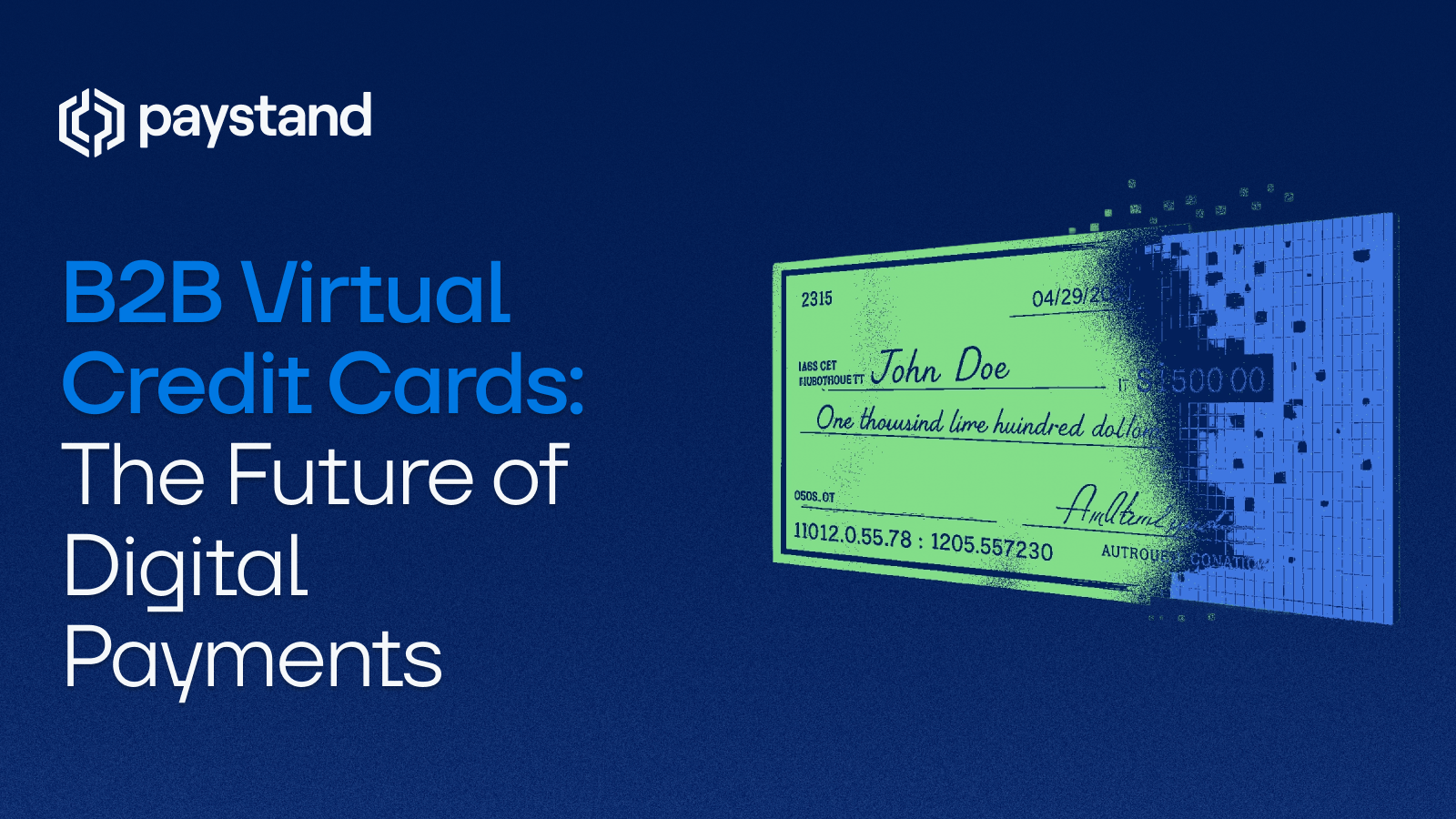B2B Virtual Credit Cards: The Future of Digital Payments

Table of Contents
- What is a B2B Virtual Credit Card and How Does It Work?
- 6 Key Benefits of B2B Virtual Credit Cards
- The Cons: How to Plan for Virtual Credit Card Downsides
- Moving Toward Virtual Accounts Management
- Taking Your Accounting to the Next Level
Key Takeaways
-
B2B virtual credit cards are reshaping business payments by offering secure, tokenized transactions that eliminate physical cards and reduce fraud risks.
-
Businesses gain greater transparency, faster payments, and improved reconciliation, leading to stronger supplier relationships and real-time financial insights.
-
Integrating virtual credit cards into virtual accounts management helps streamline AP and AR workflows, reducing manual errors and boosting operational efficiency.
-
Paystand’s Spend Management platform combines AR automation with AP innovation offering virtual cards, automated approvals, and real-time visibility to modernize enterprise finance.
The B2B payments world has a problem: late payments. According to American Express, 26% of businesses have stopped working with a supplier or buyer due to late payments. In addition, 73% of small to medium-sized businesses are negatively impacted by late payments. Unfortunately, there are many culprits causing delayed or missing payments, from honest mistakes to snail mail and fraud. On the flip side, there are simple solutions, like B2B virtual credit cards.
Although virtual technologies have been developing for years, the recent global pandemic accelerated their widespread acceptance in just about every aspect of our daily lives. It’s no wonder that business-to-business payment options are now making the shift to virtual credit cards as well.
These virtual cards provide greater control over spendingspend while making it simple for customers to make payments.
What is a B2B Virtual Credit Card and How Does It Work?
A virtual credit card is often known as a single-use account because it uniquely generates an account number that the accounts payable department of one company can use with a supplier to pay a business-to-business bill. Originally, virtual credit cards were only used by travel-related companies, including those that operated fleet vehicles when they originated at the turn of the millennium.
Today, virtual credit cards are becoming more popular as a way to boost transparency and manage cash flow. Since they are digitally tokenized, these digital credit cards add a level of security to a more convenient, hands-free, efficient payment option. This virtual account number is then connected to a company’s bank account for that single payment. They offer all the pros of traditional credit cards, with more controls and ease of use.
Virtual credit cards do not exist physically like regular plastic credit cards; they are simply randomly generated numbers created to pay for a specific product or service. Although virtual credit cards are tied to existing accounts, the tokenization process ensures that those connections are not readily accessible for security purposes.
If companies do a great deal of regular business with selected, trusted suppliers, they can use a virtual credit card called a lodge card, which carries a credit limit for invoice payments and can be used multiple times. Businesses are still able to specify the number of transactions, MCC codes, and credit limits as needed.
6 Key Benefits of B2B Virtual Credit Cards
According to Juniper Research, the “annual value of virtual cards used by businesses will grow 90 percent over the next four years, exceeding $1 trillion by 2022.” Although it still makes up a small proportion of B2B money transfer activity, virtual credit card usage will continue to increase.
Here are several benefits of switching to virtual credit cards.
1. Tighter Controls
Every single-use virtual credit card number can carry specific amounts, date ranges, expiration dates, company names, and MCC codes to limit their usage. For instance, uniquely generated virtual credit card numbers may be created to only pay a particular supplier between specific dates for a set amount of money.
These tight controls provide an added level of security for digital payments and help organizations more easily reconcile accounts and avoid errors. This, in turn, allows companies to better manage the risk of fraud.
2. Detailed Payment Notes and Data Collection
Virtual credit card transactions allow you to record extensive notes about the transaction, which can include things like project codes, cost center data, or other customized information that you may want to capture. Other payment options often have very limited data capture capabilities; ACH only allows 80 characters, and paper checks provide a short memo line.
3. Streamlined Reconciliation
Not only do virtual credit cards simplify the reconciliation process, but they also provide a complete audit trail and information to perform real-time payment analytics that can help your organization make better, faster, and smarter business decisions.
4. Faster Payments
Since virtual credit cards streamline the payment process, this means faster payment for your suppliers. They will appreciate a reduced days' sales outstanding metric and the added flexibility to access working capital by having more cash and capital available.
5. Greater Transparency and Efficiency
While much of the financial world has automated transactions, business-to-business organizations are often still stuck on antiquated, legacy systems that demand a great deal of manual work. Not only can this be a frustrating work environment for accounting professionals, but manual processes have a tendency to introduce many errors into an already complicated system, resulting in higher risks and costs. Virtual credit cards offer greater transparency while essentially eliminating human errors.
6. Win-Win for Both Parties
At the end of the day, virtual credit cards carry advantages for both the buyer and the seller of business-to-business goods and services.
For those companies doing the purchasing, they will reap direct cost savings, capture discounts, offer flexible payment methods, guarantee secure transactions, experience greater flexibility in payment options, and gain financial transparency. Those selling goods and services, on the other hand, will be able to offer flexible payment options, electronic settlements, secure transaction acceptance, timely payment options, and accurate remittance information.
The Cons: How to Plan for Virtual Credit Card Downsides
As with any new system, there may be downsides or cautions to take before making the final decision. Some things to think about when it comes to virtual credit cards include:
- High Transaction Fees: Credit card companies are known for their high, transaction-based processing fees. Unfortunately, most companies offering virtual credit cards charge the same transaction fees as conventional ones. In some cases, companies may choose to add these fees as a convenience charge to the purchasing business. In other cases, the seller may absorb the fees as overhead costs. To avoid fees, you may want to consider no-fee options likesuch as Paystand’s bank-to-bank network as a preferred payment option.
- Difficult Refunds: Since most single-use virtual credit cards use a uniquely generated number, that number disappears after the purchase is completed. As a result, refunds and return processes can become more difficult. Since the refund cannot be placed on the card number that was used for the purchase, this often means issuing a check or managing a credit account to track the return.
- Single Purchase Capability: Unless you are using a lodge card, virtual credit cards are single-use only, which means that they cannot be used for recurring payments or subscription products. Generating a unique number for repeat purchases may not be worth the hassle of this payment option.
- Processor Limitations. Before embarking on the virtual credit card adventure, check with your payment processor to ensure that they will be able to handle these payments seamlessly. The last thing you want to do is to add more manual work or another level of complexity to your accounting process.
Moving Toward Virtual Accounts Management
Virtual credit cards are one element of the evolving accounts payable and accounts receivable system. For many working in the business-to-business arena, life still revolves between different and often unintegrated systems to issue invoices, collect payments, and reconcile accounts.
Automation is an unavoidable and desperately needed next step in account management for today’s B2B companies.
For accounts payable professionals, a virtual AP system can better manage expenses with flexible issuing options that can accommodate one-time or subscription-based payments as well as simplify the reconciliation process. By integrating the AP automation with an existing enterprise resource planning (ERP) system, it’s easier than ever to streamline data and eliminate human error.
It will no longer be necessary to wait for month-end or quarter-end reports in order to make business decisions; virtual AP allows real-time visibility into current transaction data so you can generate up-to-the-minute reports whenever they are necessary. Virtual B2B credit cards can be added to payment options such as ACH, check, and bank transfers to help AP departments more easily integrate payments into their overall systems.
Managing AP virtually and using virtual credit cards can reduce manual processing and facilitate better management of vendors to improve margins, gain efficiency, and control the payment process.
Accounts receivable professionals, on the other hand, can secure faster payments if their organization is willing to accept virtual credit cards in addition to conventional forms of payment such as checks, ACH, regular credit cards, and bank transfers. The more flexible an accounts receivable department can be in terms of accepted payment forms, the more easily it can collect invoices on time.
Paystand offers an integrated payment solution for many accounts receivable departments, which allows companies to embed a “Pay Now” button into their invoices or email reminders. Once customers choose to pay an invoice, they are taken through a portal that offers all the payment options available. Paystand’s bank-to-bank network allows no-fee payment transactions; however, options such as virtual credit cards, ACH, and regular credit cards can be incorporated through the portal as well.
Taking Your Accounting to the Next Level
At Paystand, we specialize in AR. But we know that’s only half of the equation. We’re excited to now offer spend management and AP. Our solution includes B2B virtual credit cards, automated approvals, a purchasing assistant, and more.
Discover how you can transform your accounts payable process and tap into full visibility today!






